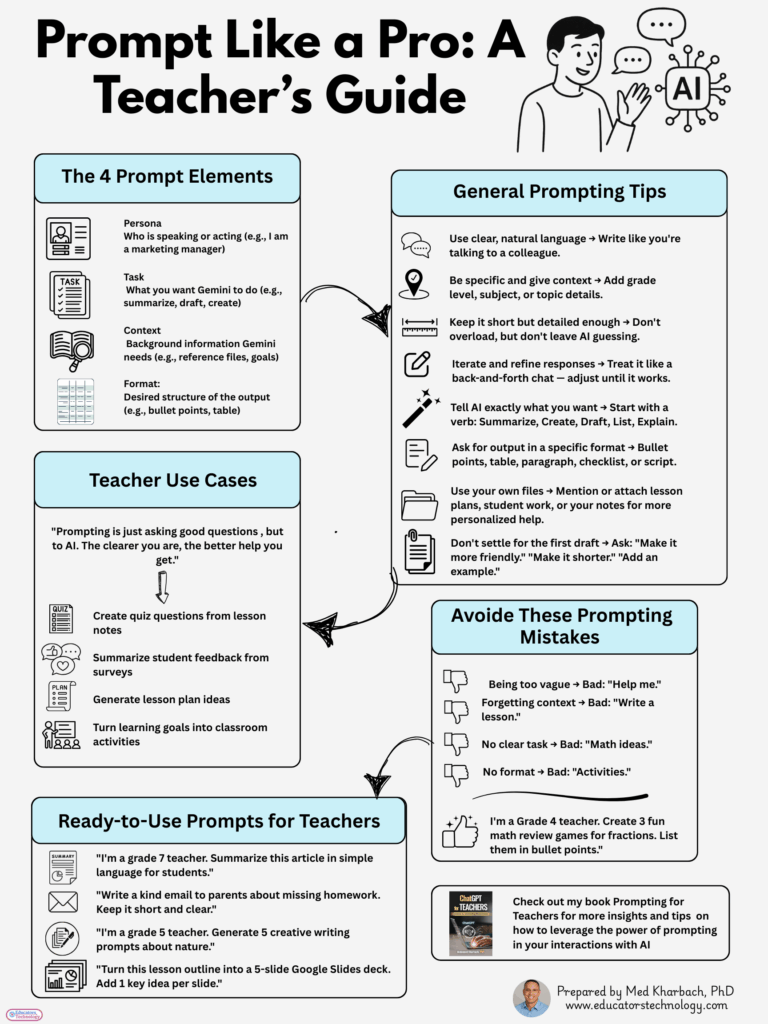Artificial intelligence has become part of our daily teaching routines, from planning lessons and creating quizzes to writing emails and generating classroom materials. Yet, the difference between a useful AI response and a confusing one often comes down to a single factor: how you prompt.
Prompting remains one of the most important skills teachers can develop today. While AI models are getting better at understanding vague or incomplete instructions, they still rely on clarity and structure to deliver results that truly match your intent. Learning how to craft effective prompts gives you more control over your AI interactions and helps you make the most of these tools in your classroom.
Below is a detailed guide that outlines the key elements of a strong prompt, practical use cases, ready-to-use examples, and common mistakes to avoid. Use it as a reference, a set of heuristics to refine how you communicate with AI tools.
Related: The Teacher’s Guide to Effective Prompting with AI
The 4 Prompt Elements
Every effective prompt includes four main components:
- Persona
Identify who is speaking or acting. This helps the AI adopt the right tone or perspective.
Example: “I am a marketing manager” or “I am a grade 5 teacher.” - Task
Specify what you want the AI to do: summarize, draft, create, rewrite, or generate.
Example: “Summarize this article,” or “Generate quiz questions.” - Context
Provide background information the AI needs, such as reference files, lesson objectives, or goals.
Example: “Use my lesson notes from Chapter 3.” - Format
Tell the AI how you want the output structured: bullet points, tables, lists, scripts, or paragraphs.
Example: “Provide the response in bullet points.”
These four elements work together to create prompts that are clear, specific, and actionable.
General Prompting Tips
Good prompting isn’t about complexity, it’s about clarity. Here are some tips to help you communicate effectively with AI:
- Use clear, natural language. Write like you’re talking to a colleague.
- Be specific and give context. Add grade level, subject, or topic details.
- Keep prompts short but detailed enough. Don’t overload the AI, but don’t leave it guessing either.
- Iterate and refine your responses. Treat it like a back-and-forth conversation until the result fits.
- Tell AI exactly what you want. Start with a strong verb: summarize, create, draft, list, explain.
- Ask for a specific format. You can request bullet points, a table, a checklist, or a short paragraph.
- Use your own materials for more tailored help, mention lesson plans, notes, or student work.
- Don’t stop at the first draft. Ask follow-up questions such as: “Make it shorter.” “Add an example.” “Make it friendlier.”
Teacher Use Cases
Prompting is just structured questioning but directed at AI. The clearer your questions, the more precise and helpful the answers become. Here are some examples of how teachers can use prompting in everyday practice:
- Create quiz questions from lesson notes.
- Summarize student feedback collected from surveys.
- Generate detailed lesson plan ideas.
- Turn learning goals into engaging classroom activities.
These small tasks save time while still keeping the teacher’s expertise at the center of the process.
Ready-to-Use Prompts for Teachers
If you’re new to prompting, here are a few ready-made examples you can try right away:
- “I’m a grade 7 teacher. Summarize this article in simple language for students.”
- “Write a kind email to parents about missing homework. Keep it short and clear.”
- “I’m a grade 5 teacher. Generate 5 creative writing prompts about nature.”
- “Turn this lesson outline into a 5-slide Google Slides deck. Add 1 key idea per slide.”
These prompts work because they include persona, task, context, and format making it easy for AI to deliver focused and relevant outputs.
Avoid These Prompting Mistakes
Some common pitfalls can lead to vague or unhelpful AI responses. Here’s what to avoid:
- Being too vague: “Help me.”
- Forgetting context: “Write a lesson.”
- Leaving out the task: “Math ideas.”
- Not specifying format: “Activities.”
Here’s a stronger version:
“I’m a Grade 4 teacher. Create three fun math review games for fractions. List them in bullet points.”

Conclusion
Prompting is more than typing a question into a chatbot, it’s a form of digital communication that shapes how AI understands you. As teachers, our ability to phrase clear, context-rich, and purposeful prompts determines how effectively we use AI in education.
While future models may handle vague or incomplete instructions better, for now, crafting good prompts remains an essential skill in every teacher’s AI toolkit. It’s the foundation of AI literacy.
To explore this topic further, check out my book ChatGPT for Teachers, where I share practical examples and frameworks to help you master the art of prompting for teaching, lesson design, assessment, and beyond.
The post Prompt Like a Pro: A Teacher’s Guide appeared first on Educators Technology.







